The Sony Cyber-shot DSC-HX50V travel-zoom camera is the World’s smallest and lightest camera with a 30x zoom lens. Offering a focal range of 24-720mm, 20.4 megapixel back-illuminated Exmor R CMOS sensor, wi-fi connectivity and built-in GPS tracking, the HX50V also has 50p Full HD video recording with stereo sound and HDMI output and 3D Sweep Panoramas and 3D Still Images. Other key features of the Sony HX50V include a 3 inch LCD screen with 921,000-dots, Multi Interface Shoe, Multi Terminal for using a remote controller, fast 0.1 second auto-focusing, 10fps burst shooting mode at full resolution, ISO range of 80-12800, Optical SteadyShot with Active Mode, full P/A/S/M manual controls, artistic Picture Effect modes, Intelligent Sweep Panoramas, and support for both Memory Stick PRO Duo and Secure Digital cards. The Sony Cyber-shot DSC-HX50V is available in black or silver for around £350 / $450.
Note that in the UK, the correct model name is Sony Cyber-shot DSC-HX50 and it doesn’t include built-in GPS tracking.
Ease of Use
The DSC-HX50V is Sony's latest travel-zoom camera, following 2012's HX20V and HX30V models. Travel-zooms now typically offer at least a 20x or even bigger lens in a compact body that you can still fit inside a pocket, but the Sony DSC-HX50V literally takes things even further with a 30x, 24-720mm extending optical lens with respectable enough maximum apertures of f/3.5 at the 24mm wide-angle setting and f/6.3 at the 720mm full telephoto setting.
The HX50V's lens is a real joy to use, with a 30x zoom in such a relatively small package making this camera incredibly adaptable, with everything from ultra-wide landscapes to candid long-distance portraits within easy reach. The 24mm focal length provides an entirely new wide angle of view that can only increase your creativity. You won't want to go back to a "standard" 35mm zoom after using the 25mm lens on the DSC-HX50V, or even a 28mm one - 4mm at the wide-angle end really does make a big difference.
When set to 720mm, the lens does admittedly extend quite a long way from the front of the HX50V, but for the most part it look to all intents and purposes like a "normal" compact camera. If that's not long enough for you, then the Clear Zoom function effectively digitally doubles the zoom range, using Sony's new Pixel Super Resolution Technology to increase the magnification. The combination of the f/3.5 aperture, effective optical image stabilizer and maximum ISO speed of 12800 makes this camera well suited to hand-held low-light photography, not to mention the wealth of dedicated shooting modes. Sony has fitted a dual image stabilisation mechanism in the shape of both optical SteadyShot and an ISO range that extends up to ISO 12800, much better than you'll find on your average point-and-shoot. Note that as with other recent Cyber-shots, you can't actually turn off the SteadyShot function, Sony assuming that its better turned on permanently.
Despite its massive zoom lens, the HX50V is still a fairly slender camera, measuring nearly 4cms at its narrowest point and weighing 272g with the battery and memory card fitted, with a large 3-inch, 921k-dot resolution LCD screen at the rear. As you'd expect with a screen of that size on such a small camera, the HX50V has no optical viewfinder to fall back on in brighter lighting conditions.
Providing the means of gripping the camera is a substantial textured, rubberised protrusion on the front and a small thumb-shaped lozenge on the rear, making the DSC-HX50V easy to get to grips with despite its mostly smooth recycled plastic surface. Also located on the front of the HX50V is the lens and a porthole on the left for the self-timer/AF illuminator. There's a pop-up flash unit on top of the camera which is automatically raised when you select a flash mode.
 | 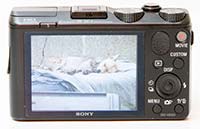 |
| Front | Rear |
Press the small On/Off button on the top plate and the Sony Cyber-shot DSC-HX50V quickly readies itself for action in a just over a second. The adequately sized shutter-release button has a definite halfway point, very quickly determining focus and exposure with a bleep of affirmation even in low-light, focus points highlighted as green rectangles on the LCD. Go on to take the shot and the JPEG images are committed to memory in a single second, the screen momentarily blanking out and then displaying the captured image before the user can go on to take a second shot.
The shutter release button is encircled by a responsive forefinger-operated push/pull rocker zoom lever, with the camera taking around five seconds to zoom from wide-angle to full telephoto. The HX50V's twin built-in stereo microphones are also located on top of the camera, either side of the new Multi Interface Shoe. Sheltered underneath the housing at the front of the hot-shoe we find a number of connector pins that allow users to mount a range of proprietary Sony accessories, which is why the company calls this accessory port a 'Multi Interface Shoe.' It can be used for attaching one of a range of accessories, including a more powerful flash, an electronic viewfinder (FDA-EV1MK), and even an optical viewfinder (FDA-V1K).
Sony have usefully added an Exposure Compensation dial to the top of the HX50V, which makes it very easy to quickly change this key setting. It has a positive clicking action and stays in place even when stored in a pocket or bag. A round shooting mode dial with a knurled edge and positive action is also found on the HX50V's top-plate, letting you quickly switch between the various shooting modes that are on offer. Sony has included Intelligent Auto scene recognition, which works in virtually identical fashion to the intelligent auto modes of Panasonic's and Canon's compact ranges. Simply point the HX50V at a scene or subject and the camera analyses it and automatically chooses one of 11 pre-optimised settings to best suit. There's also the Superior Auto mode, which places greater emphasis on reducing blur and noise and increasing the dynamic range.
Adding to the HX50V's snapshot simplicity, these features accompany face recognition and smile shutter functionality on board, the former mode biasing human faces in the frame and the latter mode firing the shutter when it detects a smiling subject. The Face Detection system automatically adjusts the focus, exposure and white balance for people in the frame, and can even be set to distinguish between children and adults. Smile Detection offers three self-explanatory options, Big, Normal and Slight. Used in conjunction, the Face and Smile Detection systems do result in more hits than misses, especially in contrasty lighting conditions, although all those smiling faces could ultimately freak you out a little! The self-portrait options in the self-timer menu work by automatically taking the shot with a two second delay after either one or two people have entered the frame.
In addition to the regular Program mode, which provides the full range of camera options and additionally allows you to change settings like the ISO speed and metering, is the welcome inclusion of Aperture-priority, Shutter-priority and Manual modes, which will instantly appeal to the more experienced photographer. The ability to choose from 30 - 1/1600th second shutter speeds and set both the aperture and shutter speed if you wish opens up a lot of creative potential. Sadly there's no support for the RAW file format, which would really have been the icing on the cake for serious photographerslooking for a backup pocket camera to their DSLR.
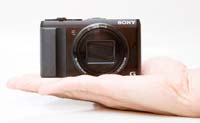 | 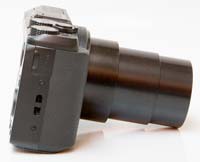 |
| Front | Side |
The Intelligent Sweep Panorama mode lets you capture a panoramic image very easily without the use of a tripod. All you need to decide is whether you would like to start from left or right, top or bottom. Then press and hold down the shutter release while doing a "sweep" with the camera in hand. Exposure compensation is available before you start the sweep, but the exposure is fixed once you depress the shutter button. After you are done with the sweeping, the camera does all the processing required, and presents you with a finished panoramic image. There are three modes, Standard, Wide and High Resolution, with the latter mode successfully stitching together a 42.9 megapixel image - not bad for a humble compact! Note that if you do the sweeping too slowly, or you let go of the shutter release button too early, the panorama will be truncated.
For those who like a healthy dose of gimmickry with their gadgets, the HX50V offers a 3D still image mode - an addition to the now expected 3D Sweep Panorama mode and the 'cheat' of the lenticular print-like Sweep Multi Angle mode, also again featured here. This option doesn't require two lenses and two sensors to produce a stereoscopic image. Instead the Sony takes two consecutive shots from two different vantage positions and combines them for its 3D effect. Like all of its stereoscopic rivals you'll still need a 3D equipped TV to properly view the results.
In the Hand-held Twilight and Anti Motion Blur shooting modes, the DSC-HX50V takes six shots in a rapid sequence, typically at a high sensitivity setting and a (relatively) fast shutter speed, and then combines them into a single image that has somewhat less noise than a single shot taken at the same ISO and exposure settings. In our experience, the difference between the two modes is that in Anti Motion Blur mode, the camera is more willing to pick a really high ISO setting like ISO 1600 to maintain a fast shutter speed, whereas in Hand-held Twilight mode, it will only go as high as absolutely necessary to avoid camera shake at the chosen focal length. If light levels are truly low, however, the HX50V will pick a high ISO speed even in this mode.
Backlight Correction HDR is a feature where the HX50V automatically shoots two frames quick succession, varying the exposure for each one then combining them to create a single image with the most detail possible in both the shadows and highlights. You can see from the example on the Image Quality page that this feature produces a photo with noticeably more dynamic range than one taken using one of the standard shooting modes, but at the same time without replicating the often "false" look of many HDR programs. Note that you should mount the camera on a tripod to avoid any unwanted camera-shake, and we were disappointed that you can only turn Backlight Correction HDR on or off, with no options for varying the intensity of the effect. Background Defocus attempts to mimic the sharp subject and out-of-focus background effect that DSLR owners typically enjoy, again shooting two frames in quick succession but this time varying the aperture.
Present and correct is the increasingly ubiquitous ability to shoot High Definition video clips, but unlike its main competitors the HX50V does so at full 1080p HD rather than 1080i or 720p, and also with stereo sound rather than mono. The various options are 1920x1280 pixels at 50p or 50i and 1440x1280 at 50i in the AVCHD format, and 1440x1280, 1280x720 or 640x480 pixels at 25fps in the MPEG4 format. During video recording you can take a 15 megapixel still image by pressing the shutter button, or alternatively grab a still from your video footage during playback.
 |  |
| Pop-up Flash | Top |
There is full use of the 30x optical zoom during recording so you can really make the most of that massive focal range, plus the ability to change the EV level, white balance, and metering options and turn on either standard SteadyShot or the Active Mode mode, which provides up to 10x more effectiveness with no side-effects. There's also a direct HDMI output from the camera, useful for playing back your footage on a HDTV set, although sadly there's no HDMI cable supplied in the box. The dedicated Movie button on the rear of the DSC-HX50V allows you to start recording a movie with a single push of a button, and then stop recording by pressing the same button. You can also activate the movie mode with adjustable settings via the Shooting Mode dial.
GPS is a feature that has slowly but surely been finding its way into digital cameras as the technology has got smaller and cheaper to implement. This potentially allows you to seamlessly geo-tag your photos (latitude and longitude co-ordinates are stored in the EXIF data) and then sort and display them using geo-friendly websites such as Google Earth and Google Maps or the supplied Picture Motion Browser PC software. The HX50V also uses the GPS to keep the camera time accurate, and can plot your progress using the new GPS Log Recording function even if the camera is turned off.
The GPS function can be manually turned on or off and the current GPS status is displayed as a small icon on the LCD screen. Three bars appear next to the icon when the GPS has synced with one or more satellites, which unfortunately takes a few minutes from powering on the camera. Thankfully once it's synced, the HX50V's GPS receiver works a lot better than most other GPS-capable cameras that we've reviewed, saving accurate positioning information for the majority of the images that we shot in built-up central London, making this camera much more useful for urban photographers. The main downside of the HX50V's GPS is the subsequent drain on battery life, with the camera only managing just over 300 shots with GPS turned on instead of the 400 that it can manage without.
The HX50V also offers built-in wi-fi connectivity. You can wirelessly transfer your photos to a smartphone or tablet that's running the free PlayMemories Mobile app, or directly to a networked PC for easier backup. You can also view on a DLNA-compatible TV via a wireless router, or send them straight from the camera a TV that supports Wi-Fi Direct. Finally, you can take control of the camera using your smartphone (fire the shutter, set the self-timer and operate the zoom), handy for including yourself in the frame or even more remote shooting.
The rear of the DSC-HX50V is dominated by the large 3 inch LCD screen, with the resolution a satisfyingly high-res 912k dots. To the right of the screen is the useful one-touch movie record button and a small button for playing back your images. Users have the ability to dip in and out of created folders of images or the calendar view, view thumbnails, select slideshows and choose transitional effects and accompanying music, or delete shots. Press the shutter button halfway and you're helpfully catapulted back into capture mode. And that's basically it. With a press of the Menu button in playback, users have access to a few in-camera retouching effects, including the ability to crop and sharpen an image and apply red-eye correction.
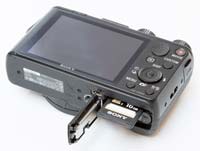 | 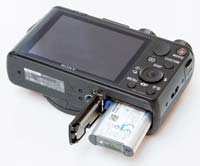 |
| Memory Card Slot | Battery Compartment |
Also on the rear is the Custom button, which as the name suggests can be customised to access one commonly used setting, such as ISO speed or Exposure Compensation. Underneath the Playback button is a traditional round navigation pad which you can use to navigate through menus and options, in conjunction with the small button in the middle which activates whatever it is you've chosen. The four directions on the navigation pad also provide a quick way of setting the Display, Flash, the Photo Creativity interface and Continuous Shooting/Timer options. The Photo Creativity makes it easier for beginners to change the colour, brightness, vividness and Picture effect modes, with changes previewed in real time on the LCD screen.
Finally, there are buttons for the camera's menu system and for deleting images underneath the navigation pad. The menu button accesses most of the camera's main functions - image size, burst settings, bracketing, exposure compensation, ISO, white balance, focus mode, metering, smile detection, and face detection - plus an icon at the bottom to open the four Settings menus. The latter includes the ability to deactivate the camera's 'bleep' that otherwise sounds at every button press, choose the movie format and activate red-eye reduction if required.
The navigation pad also doubles up as a control ring that's used to set the aperture and shutter speed in the creative shooting modes, amongst other things. The ring is a little small and over-sensitive, and having to press the tiny central button to toggle between the ISO speed, shutter speed and aperture quickly becomes a bit tiresome, but the ability to take full control of the HX50V is still very welcome.
Pressing the drive mode button brings up two options, single or burst, with high-, mid- and low-speed continuous options then available in the Menu system. Out of these, the high-speed continuous mode is the most remarkable. The HX50V takes up to 10 full-resolution photos at a frankly astounding 10 frames per second, which is faster than most compact cameras and indeed most DSLRs too. The only fly in the ointment is that once the burst is completed, it takes over fifteen seconds for the camera to clear the buffer, during which you cannot take another picture. In the other two continuous shooting modes, the Sony HX50V also takes up to 10 pictures, but at slower speeds of 5 or 2 frames per second.
The bottom of the Sony HX50V features a standard metal screw thread for attaching it to a tripod which is conveniently located in the centre. A plastic cover protects the lithium-ion battery and the removable memory card, with the HX50V supporting the SD / SDHC / SDXC format in addition to Sony's own proprietary Pro Duo Memory Stick format. There's also a hardly worth it 11MB internal memory to fall back on which can store 7 full-resolution still images. Completing the bottom of the HX50V is an unprotected the HDMI port. The right side of the HX50V has a small metal eyelet for the supplied wrist strap and also the new Multi Terminal port for using a remote controller underneath a sturdy plastic cover, while there are no controls on the left side except for a hole for the built-in microphone (looking from the rear).
No comments:
Post a Comment